Indian cuisine consists of a variety of regional and traditional cuisines native to India. Given the diversity in soil, climate, culture, ethnic groups, and occupations, these cuisines vary substantially and use locally available spices, herbs, vegetables, and fruits.

Benincasa hispida, the wax gourd, also called ash gourd, white gourd, winter gourd, winter melon, tallow gourd, ash pumpkin, Chinese preserving melon is a vine grown for its very large fruit, eaten as a vegetable when mature. It is the only member of the genus Benincasa.

Sambar is a lentil-based vegetable stew, cooked with pigeon pea and tamarind broth. It is popular in South Indian, Sri Lankan and Maldivian cuisines. The stew has been adapted into Burmese cuisine as a popular accompaniment to Burmese curries.

Biryani is a mixed rice dish originating among the Muslims of South Asia. It is made with Indian spices, vegetables, rice, and usually some type of meat, or in some cases without any meat, and sometimes, in addition, eggs and potatoes.

Sadya is a meal of Kerala origin and of importance to all Malayalis, consisting of a variety of traditional vegetarian dishes usually served on a banana leaf in Kerala as lunch. Sadya means banquet in Malayalam. Sadya is typically served as a traditional feast for Onam, the state festival of Kerala and Vishu.
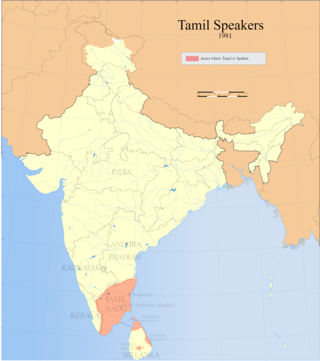
Tamil cuisine is a culinary style originating in the southern Indian state of Tamil Nadu and other countries of South Asia like Sri Lanka. Meats, along with rice, legumes, and lentils, are also popular. Dairy products and tamarind are used to provide sour flavors. On special occasions, traditional Tamil dishes are served in a traditional manner, using banana leaves in place of utensils. After eating, the banana leaves are then used as a secondary food for cattle. A typical breakfast meal consists of idli or dosa with chutney. Lunch includes rice, sambar, curd, kuzhambu, and rasam.

Idiyappam, also known as string hopper, indiappa, noolputtu, noolappam, or ottu shavige, is a string hopper dish originating from the Indian state of Kerala and Tamilnadu. It consists of rice flour pressed into noodles, laid into a flat disc-like shape and steamed. The dish also spread to Southeast Asia, where it is called putu mayam in Malaysia and Singapore, and putu mayang in Indonesia.
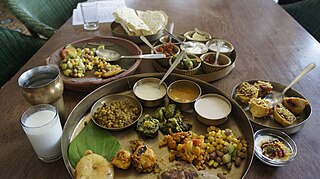
Gujarati cuisine is the cuisine of the Indian state of Gujarat. The typical Gujarati thali consists of rotli, dal or curry, rice, and shaak. The thali will also include preparations made from pulses or whole beans such as moong, black eyed beans etc., a snack item (farsaan) like dhokla, pathra, samosa, fafda, etc. and a sweet (mishthaan) like mohanthal, jalebi, doodh pak etc.
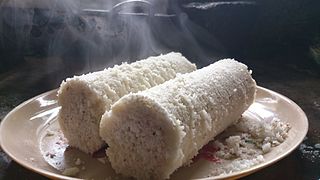
Puttu in Sri Lanka, is a dish native to Sri Lanka and the Southern Indian states of Kerala, Tamil Nadu, and parts of Karnataka. Puttu means "portioned" in Tamil and Malayalam. It is made of steamed cylinders of ground rice layered with coconut shavings, sometimes with a sweet or savory filling on the inside. Puttu is usually a breakfast dish served hot with either sweet side dishes such as palm sugar or banana, or savoury with chana masala, chutney, rasam, or meat curries.
Odia cuisine is the cuisine of the Indian state of Odisha. Compared to other regional Indian cuisines, Odia cuisine uses less oil and is less spicy, while nonetheless remaining flavourful. Rice is the staple food of this region. Mustard oil is used in some dishes as the cooking medium, but ghee is preferred in temples. In old times, food was traditionally served on copper plates or disposable plates made of sal leaves.
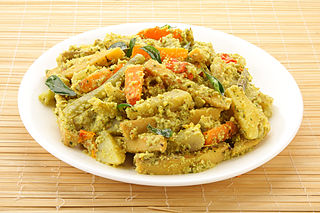
Avial is an Indian dish with origins in the Kerala, Tamil Nadu, and Udupi regions of India. It is a thick stew of usually 13 vegetables commonly found in the Western Ghats and coconut, seasoned with coconut oil and curry leaves. Avial is considered an essential part of the main meal in the region and is also served as a delicacy in South India.

Kadhi, or karhi, is a popular dish mainly consumed in South Asia. It consists of a thick gravy or soup based on gram flour, and it may contain vegetable fritters called pakora, which include dahi (yogurt) for a sour taste. It is often eaten with cooked rice or roti. Varieties of kadhi include those from Rajasthan, Maharashtra, Gujarat, Punjab, and Sindh, all of which are located in present-day India and Pakistan.

Pachadi refers to a traditional South Indian fresh pickle served as a side dish. Roughly translated, it refers to a plant which has been pounded or crushed.

Poha/Pohe is an Indian breakfast and snack prepared in the cuisines of Indian states of Maharashtra, Odisha, West Bengal, Madhya Pradesh, Telangana, Karnataka, Kerala, TamilNadu, Gujarat, Goa and Rajasthan.
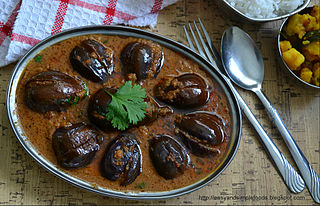
Kuḻambu, is a common dish in Tamil Nadu and Sri Lankan cuisines, and is a tamarind based dish that can include a variety of meat, vegetables, and in some cases, dal.

Malaysian Indian cuisine, or the cooking of the ethnic Indian communities in Malaysia, consists of adaptations of authentic dishes from India, as well as original creations inspired by the diverse food culture of Malaysia. Because the vast majority of Malaysia's Indian community are of South Indian descent, and are mostly ethnic Tamils who are descendants of immigrants from a historical region which consists of the modern Indian state of Tamil Nadu and Sri Lanka's Northern Province, much of Malaysian Indian cuisine is predominantly South Indian inspired in character and taste. A typical Malaysian Indian dish is likely to be redolent with curry leaves, whole and powdered spice, and contains fresh coconut in various forms. Ghee is still widely used for cooking, although vegetable oils and refined palm oils are now commonplace in home kitchens. Before a meal it is customary to wash hands as cutlery is often not used while eating, with the exception of a serving spoon for each respective dish.

Telangana cuisine refers to the Telugu cuisine native to the Indian state of Telangana. The Telangana state lies on the Deccan plateau and its topography dictates more millets and roti based dishes. Jowar and Bajra features more prominently in their cuisine.

Street food, as in other areas of India, are popular in Chennai, despite the common belief in India that street food is unhealthy. The Idly Sambhar is a popular dish, which is served as breakfast or dinner. Apart from regular South Indian street food, the city's streets are also filled with several North Indian street food outlets, most of them established by North Indian migrants themselves. Gujarati and Burmese are also available. Street food in Chennai is so popular that a game had developed based on the TV show The Amazing Race where contestants have to follow clues to Street-food spots in the city.

Congee or conjee is a type of mostly savoury rice porridge or gruel of Asian origin. It can be eaten plain, where it is typically served with side dishes, or it can be served with ingredients such as meat, fish, seasonings and flavourings, most often savory, but sometimes sweet. It is typically served as a meal on its own, especially for breakfast or people who are ill. Names for congee are as varied as the style of its preparation, but all are made with rice cooked as a softened porridge with a larger quantity of water than other types of cooked rice like pilaf or claypot rice.

Kanji is a rice water based dish traditionally prepared in Odisha. Depending on how it is prepared, it is eaten as a porridge, soup or curry. It is one of the Chappan Bhog offered to Lord Jagannath of Puri as part of the last meal of the day. During the Odia festival of Kanji Anla Osha, kanji is offered to Goddesses Sathi.



















